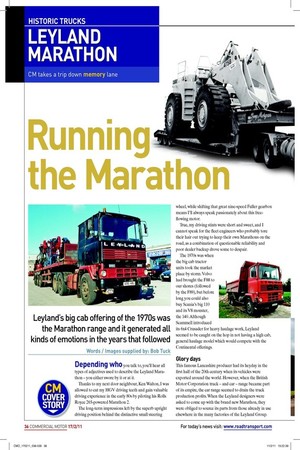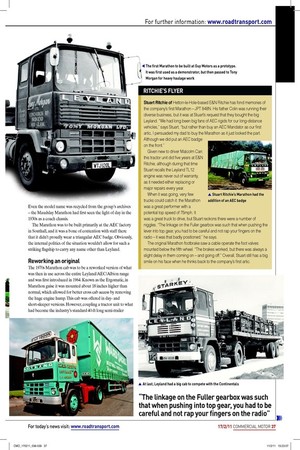Running the Marathon
Page 29

Page 30

Page 31

Page 32

If you've noticed an error in this article please click here to report it so we can fix it.
Leyland’s big cab offering of the 1970s was the Marathon range and it generated all kinds of emotions in the years that followed
Words / Images supplied by: Bob Tuck Depending who you talk to, you’ll hear all types of adjectives used to describe the Leyland Marathon – you either swore by it or at it.
Thanks to my next door neighbour, Ken Walton, I was allowed to cut my HGV driving teeth and gain valuable driving experience in the early 80s by piloting his Rolls Royce 265-powered Marathon 2.
The long-term impressions left by the superb upright driving position behind the distinctive small steering wheel, while shifting that great nine-speed Fuller gearbox means I’ll always speak passionately about this freelowing motor.
True, my driving stints were short and sweet, and I cannot speak for the leet engineers who probably tore their hair out trying to keep their own Marathons on the road, as a combination of questionable reliability and poor dealer backup drove some to despair.
The 1970s was when the big cab tractor units took the market place by storm. Volvo had brought the F88 to our shores (followed by the F89), but before long you could also buy Scania’s big 110 and its V8 monster, the 140. Although Scammell introduced its 6x4 Crusader for heavy haulage work, Leyland seemed to be caught on the hop in not having a high cab, general haulage model which would compete with the Continental offerings.
Glory days
This famous Lancashire producer had its heyday in the irst half of the 20th century when its vehicles were exported around the world. However, when the British Motor Corporation truck – and car – range became part of its empire, the car range seemed to drain the truck production proits. When the Leyland designers were asked to come up with the brand new Marathon, they were obliged to source its parts from those already in use elsewhere in the many factories of the Leyland Group. Even the model name was recycled from the group’s archives – the Maudslay Marathon had frst seen the light of day in the 1930s as a coach chassis.
The Marathon was to be built primarily at the AEC factory in Southall, and it was a bone of contention with staff there that it didn’t proudly wear a triangular AEC badge. Obviously, the internal politics of the situation wouldn’t allow for such a striking lagship to carry any name other than Leyland.
Reworking an original
The 1970s Marathon cab was to be a reworked version of what was then in use across the entire Leyland/AEC/Albion range and was frst introduced in 1964. Known as the Ergomatic, in Marathon guise it was mounted about 18 inches higher than normal, which allowed for better cross cab access by removing the huge engine hump. This cab was offered in dayand short-sleeper versions. However, coupling a tractor unit to what had become the industry’s standard 40-ft long semi-trailer while remaining within an overall length limit of 15m didn’t allow for too big a sleeper space.
The Marathon was launched in August 1973 and Gibb Grace was one of the frst to road test a fully loaded Marathon artic on CM’s 728-mile Scottish test route.
Recording a 42.7mph overall average speed at 6.5mpg, Gibb said the truck’s outstand ing performance meant it was about two hours quicker than average (for a four-axle, 32 tons [sic] gross artic) over this testing route. It’s worth noting that the light Marathon was then carrying 21 tons [sic] of payload. Gibb was very impressed with the vehicle and summarised it as: “A superb vehicle – its perform ance puts it into a class of its own at 32 tons [sic].”
The first Marathon
The frst Marathon was sold to Sun Valley Poultry in Hereford in November 1973, and archivist George Baker records that Southall built 3,071 Marathons with the last one leaving there on 29 August 1978. Guy Motors at Wolverhampton built a small number, while the Scammell plant at Watford built more than 810 Marathon 2s from April 1979 until production ended in September 1981. Only around a dozen or so 6x4 Marathons were ever built, primarily for export, although one was made especially to run in the 1980 Paris Dakar rally.
As is often the case with any truck, the best Marathons were built just before they went out of production. The Marathon 2 was launched at the 1977 Scottish Motor Show and came with the option of the bigger 290 Cummins engine. It was still turning heads.
In a subsequent comparative road test with the then newly launched Volvo F10, the Marathon was a quarter of a ton [sic] lighter, an average of 2mph faster, a clear 1mpg better on fuel, and £1,440 cheaper to buy.
All good things must come to an end
Sadly, even with all that going for it, the Marathon failed to win hearts and minds in the way the Continental imports did and after Leyland introduced its T45 Roadtrain range in 1979, the Marathon was gradually phased out.
Many Marathon drivers have a variety of thoughts on this motor, but the last word goes to British Steel driver Alan Graham who recalls that the Rotherham works operated 27 Marathons until 1988.
The double-shifted Marathons gave a sparkling performance and Alan recalls how – on the CB – his vehicle was called A Michael Edwards Rocket after the then head of Leyland.
“The truck’s never been bettered,” reckons Alan. ■












































